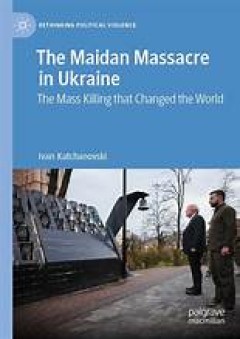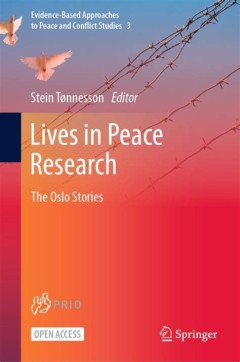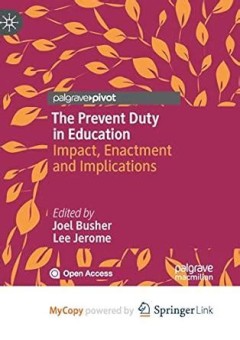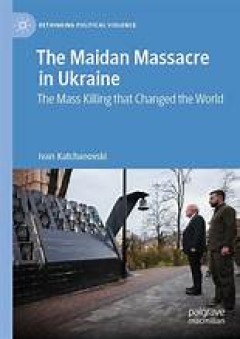Filter by

The Non-radicalisation of Muslims in Southern Europe = Migration and Integrat…
This open access book explains why southern European countries with significant Muslim communities have experienced few religiously inspired violent attacks – or have avoided the kind of securitised response to such attacks seen in many other Western states. The authors provide a unique contribution to the literature on violent extremism – which has traditionally focused on countries such a…
- Edition
- -
- ISBN/ISSN
- 9783031719967
- Collation
- XV, 124 hlm; ill., lamp.,
- Series Title
- -
- Call Number
- -

The Maidan Massacre in Ukraine
This open access book provides a comprehensive analysis of the Maidan massacre in Ukraine. It uses a theoretical framework of rational choice, moral hazard, state- repression backfire, and Weberian ideas about rational action to explore the massacre. The book draws on publicly available videos, photos and audio recordings of the massacre in English, Ukrainian, Russian, Polish and other langu…
- Edition
- 1
- ISBN/ISSN
- 978-3-031-67121-0
- Collation
- oer.unej.ac.id
- Series Title
- Rethinking Political Violence
- Call Number
- -

Lives in Peace Research = The Oslo Stories
This open access book explains how PRIO, the world’s oldest peace research institute, was founded and how it survived through crises. In this book, twenty-four of its researchers and associates, including Johan Galtung, Ingrid Eide, and Mari Holmboe Ruge, who founded the institute back in 1959, tell the stories of their roles in inventing and developing peace research. They reflect on their p…
- Edition
- 1
- ISBN/ISSN
- 9789811647178
- Collation
- XX, 508 ill; lamp
- Series Title
- 3
- Call Number
- -

The Prevent Duty in Education = Impact, Enactment and Implications
This open access book explores the enactment, impact and implications of the Prevent Duty across a range of educational contexts. In July 2015 the UK became the first country to place a specific legal requirement on those working in education to contribute to efforts to ‘prevent people from being drawn into terrorism’. Drawing on extensive research with staff, children and young people, the…
- Edition
- 1
- ISBN/ISSN
- 9783030455590
- Collation
- X, 176 hlm; ill., lamp.,
- Series Title
- -
- Call Number
- -

Counter-Terrorism, Ethics and Technology: Emerging Challenges at the Frontier…
This open access book brings together a range of contributions that seek to explore the ethical issues arising from the overlap between counter-terrorism, ethics, and technologies. Terrorism and our responses pose some of the most significant ethical challenges to states and people. At the same time, we are becoming increasingly aware of the ethical implications of new and emerging technologies…
- Edition
- -
- ISBN/ISSN
- 9783030902216
- Collation
- XVI, 221
- Series Title
- -
- Call Number
- -

Homonegativity and Religiously Motivated Political Extremism : A Study Based …
This open access book describes the world’s increasingly multicultural societies face the problem that more and more diverse lifestyles (LGBTQIA+ communities) are not universally accepted, and that today, in addition to xenophobia, racism and anti-Semitism, there is substantial homonegativity. This book explores this issue, reviews the empirical literature on the subject and provides new empi…
- Edition
- -
- ISBN/ISSN
- 978-3-031-66202-7
- Collation
- XXIII, 114
- Series Title
- SpringerBriefs in Political Science (BRIEFSPOLITICAL)
- Call Number
- 320 TAU h

Political Islam and Religiously Motivated Political Extremism : An Internatio…
This open access book presents an international comparison of religiously motivated extremism in the Arab world and around the globe. Based on data from the Arab Barometer and the World Values Survey, it applies advanced statistical techniques to analyze how religiously motivated political extremism affects political and social outcomes as well as political violence. The study clearly shows tha…
- Edition
- -
- ISBN/ISSN
- 978-3-031-24854-2
- Collation
- XXIV, 88
- Series Title
- SpringerBriefs in Political Science (BRIEFSPOLITICAL)
- Call Number
- 320 TAU p

The Maidan Massacre in Ukraine
This open access book provides a comprehensive analysis of the Maidan massacre in Ukraine. It uses a theoretical framework of rational choice, moral hazard, state- repression backfire, and Weberian ideas about rational action to explore the massacre.
- Edition
- 1
- ISBN/ISSN
- 978-3-031-67121-0
- Collation
- -
- Series Title
- Rethinking Political Violence
- Call Number
- XIX, 266

Lives in Peace Research
This open access book explains how PRIO, the world’s oldest peace research institute, was founded and how it survived through crises. In this book, twenty-four of its researchers and associates, including Johan Galtung, Ingrid Eide, and Mari Holmboe Ruge, who founded the institute back in 1959, tell the stories of their roles in inventing and developing peace research. They reflect on their p…
- Edition
- 1
- ISBN/ISSN
- -
- Collation
- -
- Series Title
- Evidence-Based Approaches to Peace and Conflict Studies
- Call Number
- XX, 508

Islamistische Gewalttaten in Westeuropa
Dieses Open-Access-Buch behandelt die Frage, wie und warum es dazu kommt, dass Menschen schwere islamistische Gewalttaten, etwa in Form terroristischer Anschläge oder gewaltsamer Hasskriminalität, in Westeuropa begehen wollen. Das im Rahmen des Buches entwickelte Erklärungsmodell nähert sich der Beantwortung dieser Frage in zwei Schritten: erstens wird erklärt, wie und warum Menschen über…
- Edition
- 1
- ISBN/ISSN
- 978-3-658-39285-7
- Collation
- -
- Series Title
- -
- Call Number
- XIII, 263
 Computer Science, Information & General Works
Computer Science, Information & General Works  Philosophy & Psychology
Philosophy & Psychology  Religion
Religion  Social Sciences
Social Sciences  Language
Language  Pure Science
Pure Science  Applied Sciences
Applied Sciences  Art & Recreation
Art & Recreation  Literature
Literature  History & Geography
History & Geography